 |
 |
| September 2012, Cape May: In August we did a trip to the U-869 aboard Joe Mazraani's boat Tenacious. I had only been to this now-famous wreck twice before--once when John Chatterton found the "Horenburg knife," and a second time years later on Harold Moyers' boat. (Due to a strange accumulation of circumstances, this third trip to the wreck was the first time I dived it with trimix--the other two times I only had air!) The wreck is not known for great visibility, and today was no exception--conditions were dark and dirty. It seems strange that the water is not clearer here, as it is far offshore. After discovering the U-550 two months ago, I had a photograph in mind (partly inspired by Tom Packer), and figured the U-869 would be a good "shallow" place to try it out. The idea was to get a shot of the U-boat's bow from ahead of it, looking back and up at the knife-edge prow--a shot just like the opening credit scene in the movie Das Boot. Joe Mazraani agreed to tow me to the bow of the wreck with his scooter, and then pose for the shot with some video lights to give the scene some scale. Much to our surprise, when we got to the bow we discovered that the very tip of the outer hull had broken off and fallen to the sand--just the part I wanted to photograph! All sorts of her innards were exposed, as well as some abandoned fishing gear, but the shot I wanted to take was no longer possible. Just another example of how shipwrecks continue to collapse as the years pass--a process no one can stop (not even NOAA!). This shot will have to wait until next summer on the U-550, provided her bow doesn't collapse before we are able to return. |
August 2012, Cape May:
Diving out of Cape May on Harold Moyers' boat Big Mac, we visited the wreck of the USS St Augustine in August. This wreck lies deep, with the bottom being a solid 250 feet down, but the visibility is nearly always fantastic, and the wreck itself is visually spectacular. This is surely one of my favorite wrecks. On this trip I decided to try and get some photos of the hundreds of chain dogfish (Scyliorhinus retifer) that are always present here, and are almost a hallmark of the wreck. These small sharks are members of the cat shark family, and are generally only found in deep water. The first time I recall seeing these guys was back in the early 1990s while diving the Billy Mitchell Wrecks. Reference books on fish species state that their habitat is in the range of 400-600 feet or deeper, but I have seen them as shallow as 200 feet. (Maybe the books need a slight revision.....).
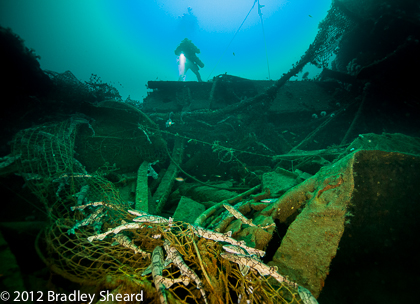 | 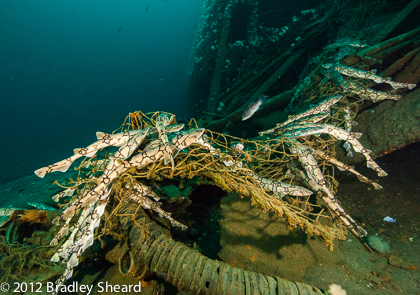 |
| Paul Whittaker looks down over the wreckage of the USS St Augustine | Chain dogfish, a type of cat shark, congregate on a twisted fishing net |
On July 23, 2012, after years of hard work, research and multiple field searches, the final resting place of the World War II German submarine U-550 was finally discovered. Finding the submarine, one of the last undiscovered German U-boats sunk off the American coast during the Second World War, has been of interest to historians, World War II buffs and divers for many years. This was an extremely exciting project and discovery for me. In my first book, Beyond Sportdiving, published in 1991, I speculated about the possibility of finding and diving this wreck if mixed gas technology was available. Only a few years later, in 1994 and 1995, I was onboard the dive boat Seeker when we dived the wreck of the Pan Pennsylvania, U-550's first and only victim, and searched unsuccessfully for the submarine. And now, nearly twenty years after those dives, we had actually found the elusive German submarine, and then returned a week later to dive it. The dive itself was both fascinating and frightening, at least for me. The wreck lies in approximately 100 meters of water, and I had not dived this deep since the mid-1990s. The water was dark but extremely clear, and the submarine itself is remarkably intact. Much of her outer hull, save the conning tower, is in excellent condition. This was certainly the highlight of the 2012 dive season for me.
|
July 2012, Cape Hatteras:
In Cape Hatteras once again. For an underwater photographer, this place is a fabulous destination during the summer. The warm, clear Gulfstream waters, combined with the fantastic and colorful marine life, and shipwrecks to boot, prove an endless delight for anyone carrying an underwater camera. Still, conditions can be frustrating here! Our first day this trip we went to no less than five different wrecks before we found a site that was diveable! The current was absolutely ripping on the offshore wrecks, and we finally got in the water on the Dixie Arrow. The current usually means clear Gulfstream water, however, and we were not disappointed in the visibllity department. This trip we even got to dive a wreck I had never seen before: the Catherine Monahan. A wooden schooner that was carrying a cargo of cement, which solidified after she sank. Over the years the hull disintegrated, leaving the cargo of cement bags neatly piled in the shape of her hull.
| 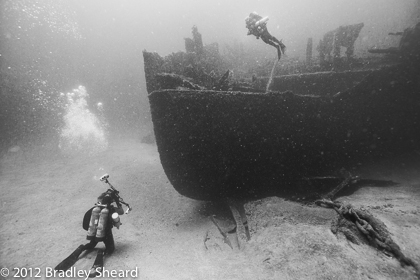 | 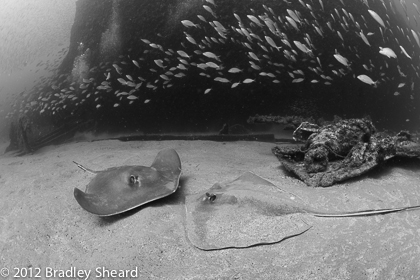 | ||
| Mike Boring photographs Karen Flynn over the bow of the Dixie Arrow | Two stingrays meet beside the Dixie Arrow | |||
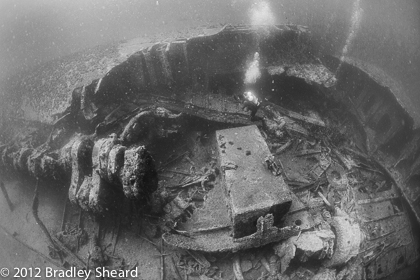 | 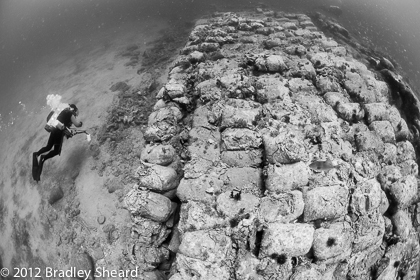 | |||
| A bird's eye view of the British Splendor's stern | "Frozen" concrete sacks mimic the shape of the hull of the Catherine Monahan |
June 2012, Cape Hatteras: Cape Hatteras abounds with World War II wrecks--many of them tankers. It seems that U-boat commanders had a certain affinity for these giant fuel-carrying ships. This is certainly understandable from a strategic point of view, since in essence they carried the life-blood of the Allied war machine. Tankers such as the Dixie Arrow, FW Abrams, Australia, Lancing and EM Clark are often high on a diver's list of potential sites when visiting these waters. An often overlooked destination, however, is the tanker Tamaulipas. Also known as the "Far East Tanker," the wreck is nearly equi-distant from Morehead City and Hatteras, and it is a long 40+-mile trip from either port. This is perhaps one of the main reasons the wreck is not visited as often as others in the area, as the weather off the Outer Banks can be an impediment to long offshore trips. The Tamaulipas, however, is worth the effort needed to get there. My first taste of the Tamaulipas was on a trip aboard Capt. Art Kirchner's Margie II back in 1993. It was one of those rare days off the Outer Banks when the ocean was as smooth as a glass table, sargassum weed dotted the surface of the sea like stars on a moonless night and flying fish skitted left and right as the boat plowed steadily southward. The Tamaulipas is broken into two pieces, and the halves lie a mile or two apart. Our first dive that trip was on the bow, which sits upside-down in 160 feet of water; three days later we returned and explored the stern, and it proved a spectacular dive. I had always wanted to return to the wreck, but the long trip often made it difficult to get to. In June 2010 appropriate weather and a charter aboard Capt JT Barker's Under Pressure finally converged, and we visited the stern--the first time I had seen the wreck in 17 years. The wreck itself had certainly collapsed downward since I had seen her last, but it still proved a fantastic dive, due in no small measure to the prolific marine life found here. While the visibility seems to be hit-or-miss, sometimes spectacular and sometimes murky, the wreck is almost always exploding with marine life. It is difficult to describe in words the scene here, but the best analogy I can come up with is a marine life rodeo. The whole wreck teems with fish life from massive schools of "bait fish" to large grouper, while sharks seem to lurk in every nook and cranny of the dark interior tank sections. Meanwhile, angry schools of amberjack race over, around and through the wreck in high-speed feeding runs, at times making a diver feel he or she is a potential target! On this particular day in June 2012 we were once again diving off JT Barker's Under Pressure. While the visibility was a bit on the murky side at about 40 feet, the marine life show proved as spectacular as ever. |
April 2012, Florida Keys: We traveled south to the Florida Keys for a week of diving and warm weather. It was intended as both a respite from the long winter, and a warm-up for the coming Northeast wreck diving season. We had done a similar trip nearly a year ago in 2011, and had a fantastic week of diving on a calm Atlantic ocean off Key Largo. I suppose the law of averages is difficult to beat, however, and this time, one-month earlier than the previous year, the winds proved a difficult adversary. We started in Key Largo, intending to begin with some of the simple artificial reefs located there. In 2011 we had wonderful dives on the USS Bibb, Duane and Spiegel Grove. We tried to visit the Duane this time, but the "water winds" were blowing fiercly, and the surface marker buoys on the wreck were all underwater, dragged down by the current. No way we were diving here! We ended up settling for a dive on Molasses Reef, with an annoying surge and poor visibility. The only reprieve was a face-on encounter with a massive Goliath grouper, who suddenly appeared out of nowhere and swam right up to me, nose-to-nose! Startled, I managed to grab a few photos before he realized I had no food and left as abruptly as he/she had appeared.
For the next three days, the wind blew too hard to even try and go diving, and we had to settle for "shore-based activities." (Any diver who has been on dive trips in less-than-optimal-conditions will understand.....) On Wednesday, we finally managed to get out on a boat again, this time out of Key West. We motored out to the Vandenberg, another artificial reef dive that was high on our list. Once again, all the mooring buoys were underwater, nowhere to be seen. The Captain said the current was running 5 knots! Clearly the conditions were un-diveable. We came inshore to an older wreck, the Cayman Salvager, where the current was only 3 knots! In the end we had to settle for another reef dive, but there were no groupers to relieve the monotony of a shallow reef in poor visibility this time. Being tossed around the bottom in a surgy snowstorm of kicked-up sand on a half-dead reef is not particuarly enjoyable. The biggest challenge on the dive was staying down long enough to not feel guilty about surfacing too early!
The following day we finally managed to get on another wreck, this time the Thunderbolt wreck off Marathon Key. Although the seas were a bit choppy, there was no current and decent visibility. The main obstacle seemed to be the dive guide, who insisted on trying to choreograph our dive profile on this "deep" wreck in 120 feet of water! The Thunderbolt was a cable-laying ship, and one of her most distincitive features is a rather large horizontal cable-laying wheel on the foredeck. It was a pleasant dive, but far too short due to our "shepherd" of a dive guide. The following day we tried for the Vandenberg once again. Although there was still an (extremely) strong current, conditions were at least diveable. It was a slow, hand-over-hand pull all the way down the anchor line to the wreck, but once there, it was possible to "hide" from the current behind the ship's superstructure. The wreck was visually spectacular (even though it isn't a "real" wreck.....). Sitting upright on the bottom in nice clear water, the main deck is reached at about 90 feet. The ship is 522 feet long, and there was no way we could swim it in a single dive, especially in the strong current we experienced. (I have heard that scootering around the whole wreck makes for a fantastic dive.) The highlight visually, and surely the wreck's icon, were the giant skeletal radar dishes. The "dishes" consist of a metallic framework in the shape of a parabolic reflector. They reminded me a bit of the Texas Tower off the New Jersey coast "back in the day." (The tower did not have radar dishes, but rather dome-shaped radomes that were originally fabric covered frameworks--all that was left when I dived it were the frameworks, and this is what the Vandenberg's dishes reminded me of.) The radars are a fascinating sight on a wreck dive, and make fabulous photographic subjects. Although I'm not personally a big fan of artificial wrecks, the Vandenberg is definitely worth a visit. |
All images, text and content Copyright © Bradley Sheard. All rights reserved.